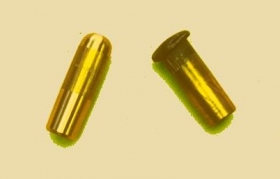Electrode face mushrooming is the normal wear mechanism of a spot welding electrode. To slow this process or prevent excessive mushrooming one must control several factors in the welding process.

EXTREME MUSHROOMING
The most common causes of excessive electrode mushrooming or wear are:
Insufficient Cooling – Water is the most important factor in electrode life.
Low Weld Force – Low weld forces create high contact resistances RC between the electrode face and work piece. This causes the face to heat excessively.
High Weld Currents – Welding with a lot of power heats the electrodes and part and can lead to wear.
Small Electrode Face Area - Too much current or force for the surface area of the electrode to withstand. This condition can exceed it's hot tensile strength.
Long Weld Time – Cause the electrodes to heat up and may exceed the cooling systems ability to dissipate the heat between welds.
Welder Head Impacts Work – The electrode can be cold forged by repeated sharp impacts if the gun or welder closes with impact.
Other factors which are less frequently the problem but cannot be over looked are:
High Weld Force
Low Conductivity Electrode Material
Reference: CMW Resistance Welding Products Catalog
RWMA - Resistance Welding Manual 4th Edition

